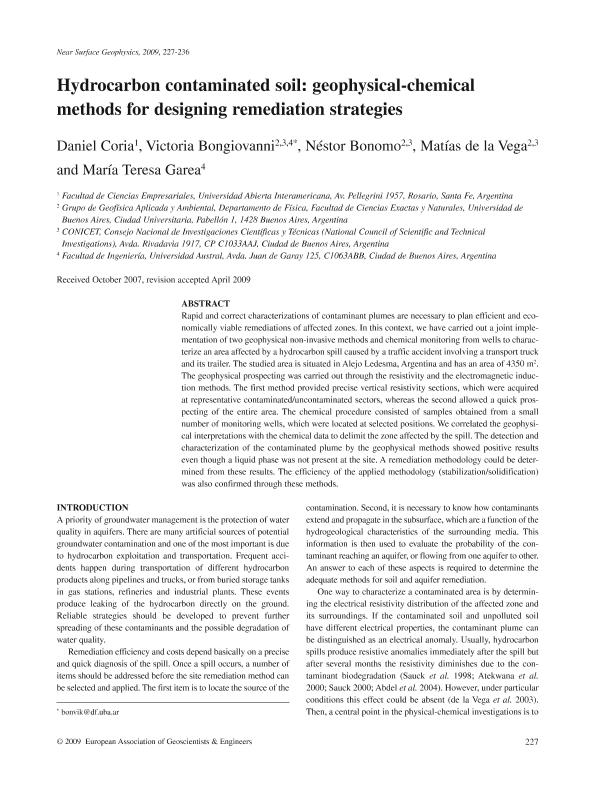Artículo
Hydrocarbon contaminated soil: geophysical-chemical methods for designing remediation strategies
Coria, Daniel Alfredo ; Bongiovanni, Maria Victoria Flavia
; Bongiovanni, Maria Victoria Flavia ; Bonomo, Nestor Eduardo
; Bonomo, Nestor Eduardo ; de la Vega, Matias
; de la Vega, Matias ; Garea, María Teresa
; Garea, María Teresa
 ; Bongiovanni, Maria Victoria Flavia
; Bongiovanni, Maria Victoria Flavia ; Bonomo, Nestor Eduardo
; Bonomo, Nestor Eduardo ; de la Vega, Matias
; de la Vega, Matias ; Garea, María Teresa
; Garea, María Teresa
Fecha de publicación:
06/2009
Editorial:
European Association of Geoscientists & Engineers
Revista:
Near Surface Geophysics
ISSN:
1873-0604
e-ISSN:
1569-4445
Idioma:
Inglés
Tipo de recurso:
Artículo publicado
Clasificación temática:
Resumen
Rapid and correct characterizations of contaminant plumes are necessary to plan efficient and economically viable remediations of affected zones. In this context, we have carried out a joint implementation of two geophysical non-invasive methods and chemical monitoring from wells to characterize an area affected by a hydrocarbon spill caused by a traffic accident involving a transport truck and its trailer. The studied area is situated in Alejo Ledesma, Argentina and has an area of 4350 m2. The geophysical prospecting was carried out through the resistivity and the electromagnetic induction methods. The first method provided precise vertical resistivity sections, which were acquired at representative contaminated/uncontaminated sectors, whereas the second allowed a quick prospecting of the entire area. The chemical procedure consisted of samples obtained from a small number of monitoring wells, which were located at selected positions. We correlated the geophysical interpretations with the chemical data to delimit the zone affected by the spill. The detection and characterization of the contaminated plume by the geophysical methods showed positive results even though a liquid phase was not present at the site. A remediation methodology could be determined from these results. The efficiency of the applied methodology (stabilization/solidification) was also confirmed through these methods.
Palabras clave:
Suelos
,
Contaminación
,
Remediación
,
Hidrocarburos
Archivos asociados
Licencia
Identificadores
Colecciones
Articulos(IFIBA)
Articulos de INST.DE FISICA DE BUENOS AIRES
Articulos de INST.DE FISICA DE BUENOS AIRES
Articulos(SEDE CENTRAL)
Articulos de SEDE CENTRAL
Articulos de SEDE CENTRAL
Citación
Coria, Daniel Alfredo; Bongiovanni, Maria Victoria Flavia; Bonomo, Nestor Eduardo; de la Vega, Matias; Garea, María Teresa; Hydrocarbon contaminated soil: geophysical-chemical methods for designing remediation strategies; European Association of Geoscientists & Engineers; Near Surface Geophysics; 7; 3; 6-2009; 227-236
Compartir
Altmétricas



